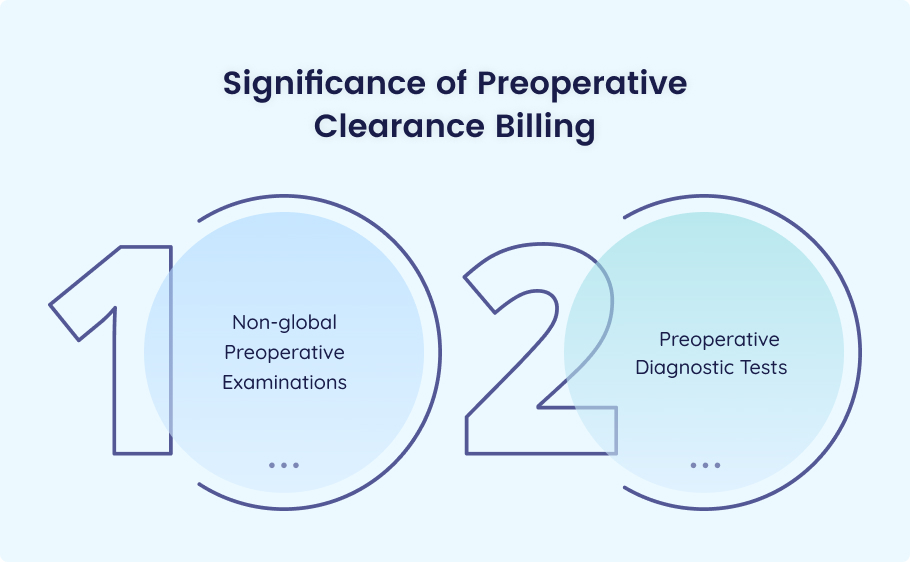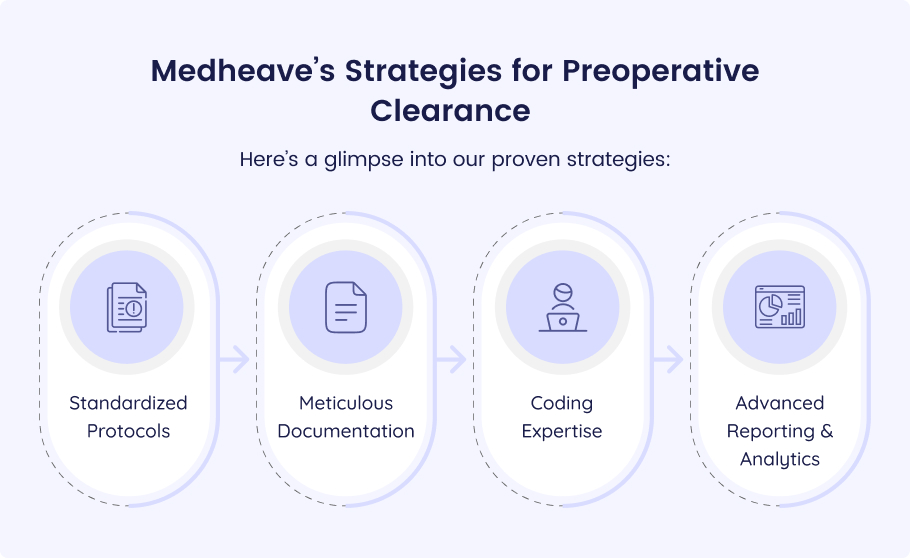
In the fast-paced arena of surgical care, having optimal health for the patients prior to the operation is the most decisive matter. Clearance before the surgery in this process is one of the key aspects that involve careful evaluations and tests to lower chances of surgical risks and improve outcomes. However, a lot of practices struggle to keep afloat and to continue their work due to the delays of the reimbursements, denials of claim and the continuous change of regulations.
This guideline by Medheave-Medical Billing company equips you with the knowledge and best practices to excel in preoperative clearance billing.
Preoperative clearance is important because it helps to ensure that patients are in a good health state before going through surgery, which subsequently decreases risks and leads to better outcomes. Accurate billing is key to maintaining your practice’s fair compensation for the time and effort invested in patient care management.
There are studies that indicate that incorrect coding and billing are among the reasons to stop up with money losses in healthcare. The American Medical Association’s recent data clearly shows that billing errors lead to the denial of a significant number of claims, accounting for approximately 12% of all healthcare bills. This becomes the reason for industry to shed a billion dollars per year.
Key Services Covered
The preoperative billable services fall under two categories:
- Non-global Preoperative Examinations
- Preoperative Diagnostic Tests
Non-global Preoperative Examinations
New vs. Established Patients: Whether or not the patient is new to your practice or you have a long-term relationship, the complexity of E/M code selection will still depend on his or her condition. New patient consultations for complex surgeries (coding 99223) commonly involve a more thorough history and physical examination compared to established patient visits (coding 99214), which are mostly concentrated on reviewing existing medical conditions and surgical risk.
Consultation vs. Visit: Differentiating between a consultation and routine practice is crucial. The doctor usually sends the consultations to evaluate their patient for a potential surgical risk. After that the patient initiates the regular visits.
Preoperative Diagnostic Tests
Test Specificity: The correct coding for the diagnostic tests usually requires exact details, though not always. Avoid using generic terms, such as “blood test.” Instead, provide specific details about the performed test, like “complete blood count” or “comprehensive metabolic panel (CMP).”
Test Justification: Just like E/M examinations, the documentation for preoperative diagnostic tests has to express the medical necessity with great clarity. It should answer the questions such as: what is the reason for this particular lab’s conduct? What is the connection between the surgery and the patient’s risk profile?
Despite its vital importance in cases of surgical safety as well as optimal surgical outcomes, preoperative clearance billing should be tackled with caution due to its complexity.
Prove Its Medical Necessity
The Problem: According to AMA Report 2023, a staggering 12% of healthcare bills get rejected due to a variety of billing errors. That’s a lot of money loss for healthcare providers.
The Solution: Clear documentation is your defense against unjustified denials. In particular, justify why both E/M and diagnostic services had to be provided. Explain the specific surgery planned, the patient’s history, any risk factors, and how each service contributes to preparing the patient for surgery.
Example: A patient with previous heart disease is planning to undergo knee replacement surgery. Documenting the preoperative cardiac assessment (E/M code 99214) that involves the cardiac health check and the potential complications during surgery supports the request for medical necessity.
Code Right, Get Paid Right
The Problem: Coding using CPT® and HCPCS codes requires accuracy and precision. Even a slight error, either in a misplaced modifier or an erroneous diagnosis code, will lead to claim denial and delay.
The Solution: Invest in expertise. Partner with a third-party medical billing company such as Medheave or train your staff on the specifics of preoperative clearance coding. Our AAPC-certified coder team will keep up with the most recent coding regulations and know the exact rules that apply to this billing category. This results in the right code selection for E/M services, diagnoses, and modifiers, thus reducing claiming rejections.
Medheave Advantage: Our internal reports demonstrate a 99% accuracy rate in preoperative clearance coding. Thus, greatly eliminates denials and maximizes reimbursements for our partner practices.
The Challenge: Generic coding practices can relegate appropriate billing and reimbursement categories and, therefore, lead to missed opportunities for reimbursement. This could include leaving out specific CPT® codes for tests like a CBC or CMP in the case where the term “blood test” is used rather than the “CPT code” alone.
The Solution: Embrace specificity. In ICD-10 codes, both the selection of E/M class codes and the diagnostic test code require careful and exact details. In the case of an E/M code, we must focus on recording details of the surgical plan, the patient’s health records, determined risk factors, and the time spent on the consulting part.
Example: Conducting a “cardiovascular evaluation (E/M code 99214)” by describing the patient’s diseases, which have to do with the heart, risk factors for problems in operations, and a picture, which shows what happened to the patient during the checkup, creates a picture for coding and billing.
With Medheave Medical Billing, multiple surgery clinics experienced financial stability due to our data-driven approach and unparalleled knowledge of preoperative clearance billing. Here’s a glimpse into our proven strategies:
Standardized Protocols
We work alongside your team to create specific and regular rules covering preoperative scrutiny and testing for each type of surgery. This standardization allows for the completion of services and billing, which were not possible otherwise because of errors and inefficiencies.
Meticulous Documentation
Our staff is trained to ensure your in-house staff follows accurate documentation systems. This includes recording facts such as surgery type, patient history, risk factors for the patient (if any), and the reasons behind truth testing. A wide-ranging filing of evidence will improve your case and prevent denials.
Coding Expertise
We have a group of AAPC coders who are certified and skilled to utilize the CPT® and HCPCS codes appropriately, specifically the preoperative clearance billing processing requirements. We apply our expertise to ensure a correct code choice for E/M visits, primary as well as secondary diagnosis and modifier, thus reducing the possibility of claim rejection.
Advanced Reporting & Analytics
Medheave makes the reporting and analytics in real-time to put in front of you a photo of the billing performance of your patient’s preoperative clearance. These statistics monitor indicators such as duration and denial quotes, turnaround time for claim handling, and coding accuracy.
Feel free to Contact us at (888) 487-1178 for error free preoperative clearance billing services.












